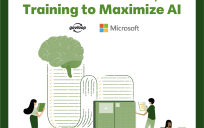Directing information technology operations for the ninth-largest city in the United States, serving some 1.3 million people, is no small task.
But as the Chief Information Officer (CIO) for the city of Dallas and a former federal IT executive, Bill Zielinski is no stranger to tackling complex issues with technology. High on his list is a pervasive challenge that cities and federal agencies across the nation are grappling with: how to use data — in all its forms — to make timely decisions, deliver better services and support the public, especially during COVID-19.
“There is so much collection of this information happening at the edge,” Zielinski said during GovLoop’s virtual summit Thursday, hosted in partnership with Dell and Carahsoft. Government work isn’t relegated to the four walls of an office, which is particularly true today, and the data employees need to do their jobs shouldn’t be either, he said.
“We are seeing about 85% of enterprises adopt a multi-cloud structure into the future,” said Dallas Nash, Senior Director of Sales, Unstructured Data Solutions at Dell Technologies. For many organizations, much of their decision-informing data exists at the edge of the network, and a multi-cloud strategy allows customers to start gleaning data in that environment.
Smart cities are at the epicenter of delivering unstructured data, Nash said. They are using sensors, autonomous driving vehicles and drones, and so are military personnel and other federal entities.
One example is the city of Dallas, where Zielinski is CIO. Similar to other cities, it uses cameras and sensors to capture real-time footage, whether of traffic conditions or the health of roads and sidewalks. The goal is to use data, algorithms and cloud technologies to spot trends and glean intelligence about what issues the city has and where it should dedicate its resources. Zielinski is also eyeing capabilities such as artificial intelligence and robotic process automation to accelerate business outcomes and free up employees to tackle higher-value work.
He stressed the importance of looking across common data sets that can be used by multiple departments — such as animal services, code compliance, and police or fire rescue — to better understand the state of affairs in the city and how best to service residents.
As governments, especially at the state and local levels, face immense budget pressures due to COVID-19, they may need to re-evaluate what services they can deliver, how they deliver those services, and what that means for customers, Nash said.
Nash shared how centralized repositories can give organizations a broader view of their environment by breaking down data silos.
“Don’t manage your data like it’s 1999,” he said. “If you are buying capacity like you were 10 years ago, you are talking to the wrong people.”
Both Zielinski and Nash shared these data-focused approaches for agencies to keep in mind:
1. “It’s easy to fall in love with the underlying technology, but you always have to ground yourself in solving a business problem or answering a business question,” Zielinski said.
2. “If you can’t answer your business questions today at all, even imperfect data is probably going to get you more intelligence” than you currently have, Zielinski added. “Something that has flaws and warts is probably better than the nothing you are using today.” His advice: Don’t let perfect be the enemy of good.
If you are concerned about the accuracy of your data, include caveats about your confidence level of the data, he said. But if you wait for perfection, you will never get value. Let your data see the light of day.
3. Agencies need a process for managing unstructured data — and a process for gleaning business value from unstructured data. In many ways, data scientists are helping to lead that charge.
4. But you have to team your data scientists with individuals who have subject matter expertise, Zielinksi said, no matter the business challenge your agency is trying to solve.
Don’t miss out on other virtual learning opportunities. Pre-register for GovLoop’s remaining 2020 virtual summits today.
This online training was brought to you by:





Leave a Reply
You must be logged in to post a comment.